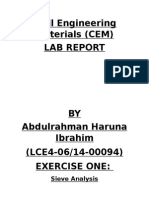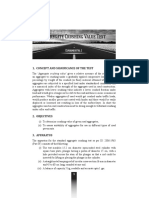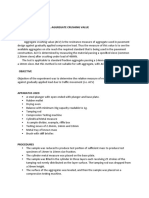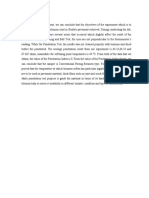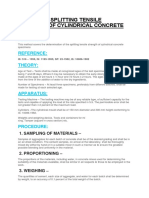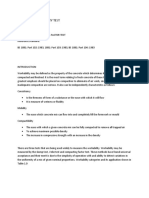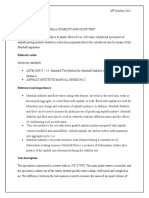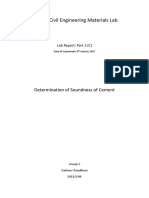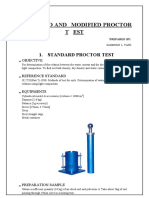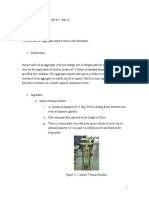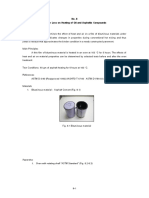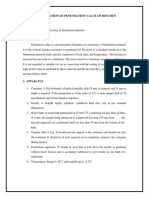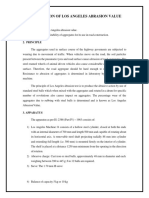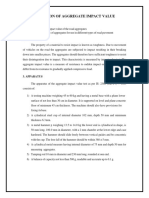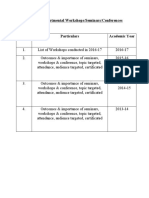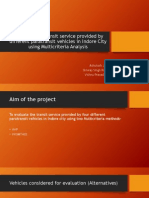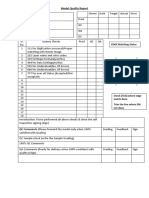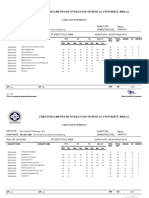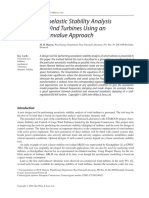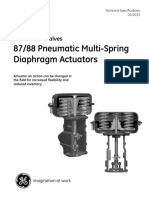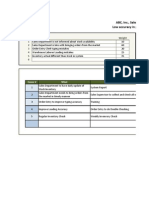Crushing Test PDF
Crushing Test PDF
Uploaded by
AshishJamadarCopyright:
Available Formats
Crushing Test PDF
Crushing Test PDF
Uploaded by
AshishJamadarOriginal Title
Copyright
Available Formats
Share this document
Did you find this document useful?
Is this content inappropriate?
Copyright:
Available Formats
Crushing Test PDF
Crushing Test PDF
Uploaded by
AshishJamadarCopyright:
Available Formats
Experiment No.
DETERMINATION OF AGGREGATE CRUSHING VALUE
1. AIM
1) To determine the aggregate crushing value of coarse aggregates
2) To assess suitability of aggregates for use in different types of road pavement
2. PRINCIPLE
The aggregate crushing value gives a relative measure of the resistance of an
aggregate to crushing under a gradually applied compressive load. Crushing value is a
measure of the strength of the aggregate. The aggregates should therefore have minimum
crushing value.
3. APPARATUS
The apparatus of the aggregate crushing value test as per IS: 2386 (Part IV) – 1963
consists of:
1) A 15cm diameter open ended steel cylinder with plunger and base plate, of the
general form and dimensions as shown in Fig 1.
2) A straight metal tamping rod of circular cross-section 16mm diameter and 45 to 60
cm long, rounded at one end.
3) A balance of capacity 3k, readable and accurate up to 1 g.
4) IS Sieves of sizes 12.5,10 and 2.36 mm
5) A compression testing machine capable of applying a load of 40 tonnes and which can
be operated to give a uniform rate of loading so that the maximum load is reached in
10 minutes. The machine may be used with or without a spherical seating
6) For measuring the sample, cylindrical metal measure of sufficient rigidity to retain its
form under rough usage and of the following internal dimensions:
Diameter 11.5 cm
Height 18.0 cm
1 DEPT. OF CIVIL ENG., MAHARSHI PARSHURAM COLLEGE OF ENGG,VELNESHWAR
Fig 1 AGGREGATE CRUSHING TEST APPARATUS
4. PROCEDURE
The test sample: It consists of aggregates sized 12.5 mm - 10.0 mm (minimum 3kg).
The aggregates should be dried by heating at 100-110o C for a period of 4 hours and cooled.
1) Sieve the material through 12.5 mm and 10.0 mm IS sieve. The aggregates passing
through 12.5 mm sieve and retained on 10.0 mm sieve comprises the test material.
2) The cylinder of the test shall be put in position on the base-plate and the test sample
added in thirds, each third being subjected to 25 strokes with the tamping rod.
3) The surface of the aggregate shall be carefully levelled.
4) The plunger is inserted so that it rests horizontally on this surface, care being taken to
ensure that the plunger does not jam in the cylinder
5) The apparatus, with the test sample and plunger in position, shall then be placed
between the plates of the testing machine.
6) The load is applied at a uniform rate as possible so that the total load is reached in 10
minutes. The total load shall be 40 tones.
7) The load shall be released and the whole of the material is removed from the cylinder
and sieved on 2.36mm IS Sieve.
8) The fraction passing the sieve shall be weighed and recorded.
2 DEPT. OF CIVIL ENG., MAHARSHI PARSHURAM COLLEGE OF ENGG,VELNESHWAR
Record of Observation
Sample I Sample II
Total weight of dry sample taken= W1
gm
Weight of portion passing 2.36 mm
sieve= W2 gm
Aggregate crushing = (W2/W1)*100
Value (percent)
Aggregate Crushing Mean Value =
5. REPORTINGOFRESULTS
The mean of the two results shall be reported to the nearest whole number as the ‘aggregate
crushing value’ of the size of the material tested.
6. RESULT
Aggregate Crushing test value =
3 DEPT. OF CIVIL ENG., MAHARSHI PARSHURAM COLLEGE OF ENGG,VELNESHWAR
You might also like
- Civil Engineering Material Lab ReportDocument13 pagesCivil Engineering Material Lab Reportsharrmaa100% (1)
- Determination of Aggregate Crushing ValueDocument13 pagesDetermination of Aggregate Crushing Valuealeena4100% (2)
- Aggregate Crushing Value Test Lab ReportDocument2 pagesAggregate Crushing Value Test Lab ReportComr A Y ZarginaNo ratings yet
- Field Dry Density Test Using Sand Replacement MethodDocument29 pagesField Dry Density Test Using Sand Replacement MethodJassel Jalandoni100% (1)
- Aggregate Crushing Value Test: Experiment No. 1Document5 pagesAggregate Crushing Value Test: Experiment No. 1Vishakha Patel100% (1)
- Experiment No. Name of The Experiment: Aggregate Impact Test AIM OF THE EXPERIMENT: To Determine The Aggregate Impact Value ofDocument4 pagesExperiment No. Name of The Experiment: Aggregate Impact Test AIM OF THE EXPERIMENT: To Determine The Aggregate Impact Value ofBibhuti B. BhardwajNo ratings yet
- ACV TFV and AIVDocument7 pagesACV TFV and AIVBernard Kitosi100% (1)
- Elongation Index TestDocument2 pagesElongation Index TestBibhuti B. Bhardwaj60% (5)
- Viscosity Lab ReportDocument7 pagesViscosity Lab Reportcharishma takkallapalliNo ratings yet
- 34) Extraction of Bitumen From Paving MixturesDocument6 pages34) Extraction of Bitumen From Paving MixturesPn EkanayakaNo ratings yet
- Rebound HammerDocument6 pagesRebound Hammerahmadfarriz100% (1)
- Summary:: Stability: Is The Maximum Load Resistance in Newton (LB.) That TheDocument10 pagesSummary:: Stability: Is The Maximum Load Resistance in Newton (LB.) That TheAli M. Chehadeh100% (1)
- Flakiness & Elongation TestDocument7 pagesFlakiness & Elongation TestIkhwan Z.No ratings yet
- CONCLUSION Bitumen TestDocument1 pageCONCLUSION Bitumen TestFirash Imran100% (1)
- Experiment-5 Flakiness Index (FI) Objective Theory: Minimum Mass of Test PortionDocument1 pageExperiment-5 Flakiness Index (FI) Objective Theory: Minimum Mass of Test PortionRefisa Jiru0% (1)
- Flash and Fire Point TestDocument11 pagesFlash and Fire Point TestWily RustamNo ratings yet
- Bitumen ExtractorDocument7 pagesBitumen ExtractorNirmal NayakNo ratings yet
- Aggregate Shape Test (Flakiness Index & Elongation Index) Group 5 - Section 7Document9 pagesAggregate Shape Test (Flakiness Index & Elongation Index) Group 5 - Section 7Beman EasyNo ratings yet
- WorkabilityDocument3 pagesWorkabilityyay94rebuildNo ratings yet
- Rebound Hammer TestDocument7 pagesRebound Hammer TestHaider AliNo ratings yet
- Flakiness FullDocument11 pagesFlakiness FullIsabelle FGNo ratings yet
- Determine Splitting Tensile Strength of Cylindrical Concrete SpecimensDocument5 pagesDetermine Splitting Tensile Strength of Cylindrical Concrete SpecimenssuryakantameNo ratings yet
- Ductility Test PDFDocument4 pagesDuctility Test PDFAshishJamadarNo ratings yet
- CBR Test ReportDocument5 pagesCBR Test ReportSamanta Pandey100% (1)
- Determination of Flakiness and Elongation Index For The Given Aggregate Sample.Document4 pagesDetermination of Flakiness and Elongation Index For The Given Aggregate Sample.Huma AliNo ratings yet
- Lab Report 1 DETERMINATION OF AGGREGATE IMPACT VALUE (AIV) (BS 812-112)Document3 pagesLab Report 1 DETERMINATION OF AGGREGATE IMPACT VALUE (AIV) (BS 812-112)Kashif IqbaljNo ratings yet
- Concrete Workability TestDocument3 pagesConcrete Workability TestEyzatul QhairinaNo ratings yet
- Los AngelesDocument2 pagesLos AngelesAbdulelah SNo ratings yet
- Marshall Stability and Flow TestDocument5 pagesMarshall Stability and Flow TestBhaskar Pratim Das75% (4)
- Compressive Strength of Concrete - Cube Test, Procedure, Apparatus & ResultsDocument30 pagesCompressive Strength of Concrete - Cube Test, Procedure, Apparatus & ResultsAnonymous Qm0zbNkNo ratings yet
- Aggregates Lab Report PDFDocument5 pagesAggregates Lab Report PDFcharishma takkallapalliNo ratings yet
- Penetration Test Lab ReportDocument7 pagesPenetration Test Lab ReportAmirul Faris100% (1)
- Soundness Test CementDocument3 pagesSoundness Test CementgarimaNo ratings yet
- Lab Manual Reinforced Concrete-II Submitted To: Engr. Usman Ali Submitted By: Group # 03 Athar Rafiq (06) Moudud Ul Islam (26) Taimoor RazaDocument6 pagesLab Manual Reinforced Concrete-II Submitted To: Engr. Usman Ali Submitted By: Group # 03 Athar Rafiq (06) Moudud Ul Islam (26) Taimoor RazaMoudud Ul Islam Awan100% (2)
- Direct Shear Test ReprtDocument4 pagesDirect Shear Test ReprtShivaraj SubramaniamNo ratings yet
- Standard and Modified Proctor TestDocument6 pagesStandard and Modified Proctor TestHarsh PatelNo ratings yet
- Aggregate Impact ValueDocument7 pagesAggregate Impact ValuewanNo ratings yet
- Compressive Strength Test: Lab ReportDocument4 pagesCompressive Strength Test: Lab ReportRaymart Calano RubenNo ratings yet
- Penetration Test On BituminousDocument3 pagesPenetration Test On BituminousM Zeeshan Haider100% (2)
- Test of AggregateDocument24 pagesTest of AggregatePriyank BhimaniNo ratings yet
- Experiment No. 7 Bulking of SandDocument1 pageExperiment No. 7 Bulking of SandShubham GautamNo ratings yet
- 3 Methods of Determining Workability of ConcreteDocument4 pages3 Methods of Determining Workability of Concretesuryakantame100% (1)
- Fresh Concrete Vebe TestDocument2 pagesFresh Concrete Vebe TestMarilyn Camenzuli100% (1)
- Structural Materials LAB REPORTDocument10 pagesStructural Materials LAB REPORTmusiomi2005No ratings yet
- Highway Lab Report 9,10 and 11Document22 pagesHighway Lab Report 9,10 and 11Abdallah AlhasanNo ratings yet
- Bitumen ExtractionDocument9 pagesBitumen ExtractionAbdhul Khadhir ShalayarNo ratings yet
- Concrete Split-Tensile Strength Test: Practical Report Construction Material TechnologyDocument4 pagesConcrete Split-Tensile Strength Test: Practical Report Construction Material TechnologyCharistaNo ratings yet
- Specific Gravity Test of Bitumen (AASHTO T-228, ASTM D-70) Object: To Determine Specific Gravity Test of BitumenDocument4 pagesSpecific Gravity Test of Bitumen (AASHTO T-228, ASTM D-70) Object: To Determine Specific Gravity Test of BitumenYasir Dharejo0% (2)
- Highway Lab ReportDocument9 pagesHighway Lab Reportcarlton0878% (9)
- Aggregate Impact Test, Ten Percent Fines TestDocument6 pagesAggregate Impact Test, Ten Percent Fines TestEmrePınarcı75% (4)
- No. 8 Test For Loss On Heating of Oil and Asphaltic CompoundsDocument4 pagesNo. 8 Test For Loss On Heating of Oil and Asphaltic Compoundssaiye.w58 RSU50% (2)
- Soundness of CementDocument3 pagesSoundness of CementKrishnaChaitanya100% (1)
- Loose Bulk DensityDocument5 pagesLoose Bulk DensityDevi PrasadNo ratings yet
- Aggregate Impact Value TestDocument5 pagesAggregate Impact Value TestMind Rip100% (1)
- Aggregate Crushing ValueDocument3 pagesAggregate Crushing ValuemuralidharanNo ratings yet
- Crashing TestDocument11 pagesCrashing Testhimura kenshinNo ratings yet
- High Way Lab - Manual - VsemDocument40 pagesHigh Way Lab - Manual - VsemYohannesNo ratings yet
- Transpo Lab ManualDocument27 pagesTranspo Lab Manualbaba pappuNo ratings yet
- Test 14Document2 pagesTest 14hermioneg1011No ratings yet
- Aggregate Crushing ValueDocument2 pagesAggregate Crushing Valuekausik nathNo ratings yet
- Penetrometer Test PDFDocument4 pagesPenetrometer Test PDFAshishJamadarNo ratings yet
- Los Angeles Abrasion Test PDFDocument6 pagesLos Angeles Abrasion Test PDFAshishJamadar100% (3)
- Viscometer Test PDFDocument2 pagesViscometer Test PDFAshishJamadarNo ratings yet
- Aggregate Impact ValueDocument6 pagesAggregate Impact ValueAshishJamadarNo ratings yet
- Sthapatyam IndexDocument1 pageSthapatyam IndexAshishJamadarNo ratings yet
- Ductility Test PDFDocument4 pagesDuctility Test PDFAshishJamadarNo ratings yet
- Bridge EngineeringDocument4 pagesBridge EngineeringAshishJamadarNo ratings yet
- Ductility Test PDFDocument4 pagesDuctility Test PDFAshishJamadarNo ratings yet
- T.E Assign Pract SheetDocument19 pagesT.E Assign Pract SheetAshishJamadarNo ratings yet
- Suitability of SoilsDocument15 pagesSuitability of SoilsAshishJamadarNo ratings yet
- Index of Departmental WorkshopsDocument2 pagesIndex of Departmental WorkshopsAshishJamadarNo ratings yet
- Evaluation of Transit Service Provided by Different Paratransit Vehicles in Indore City Using Multicriteria AnalysisDocument6 pagesEvaluation of Transit Service Provided by Different Paratransit Vehicles in Indore City Using Multicriteria AnalysisAshishJamadarNo ratings yet
- Model Quality Report: EDGE Matching StatusDocument1 pageModel Quality Report: EDGE Matching StatusAshishJamadarNo ratings yet
- Ashutosh Highway GeometricsDocument35 pagesAshutosh Highway GeometricsAshishJamadarNo ratings yet
- 11 Curriculum-Mason Marble, Granite & Stone L4Document10 pages11 Curriculum-Mason Marble, Granite & Stone L4AshishJamadarNo ratings yet
- Skoda Octavia 3 Axles Steering EngDocument366 pagesSkoda Octavia 3 Axles Steering EngPaulicsek ZoltánNo ratings yet
- ASHIRVADDocument1 pageASHIRVADMohamed HachichaNo ratings yet
- MT Series BrochureDocument2 pagesMT Series Brochurecarlitos_10No ratings yet
- NS-85P、NS-85LP Automatic Cuff Blocking Machine V1.00Document2 pagesNS-85P、NS-85LP Automatic Cuff Blocking Machine V1.00Liaqat Mahmood MughalNo ratings yet
- Chhattisgarh Swami Vivekanand Technical University, BhilaiDocument4 pagesChhattisgarh Swami Vivekanand Technical University, BhilaiNikhil ChaubeyNo ratings yet
- TM 11-5820-765-12 - Power - Supplies - PP-4763 - 1968 PDFDocument39 pagesTM 11-5820-765-12 - Power - Supplies - PP-4763 - 1968 PDFWurzel1946No ratings yet
- 15 Ceragon IP 10G EMS BackupDocument26 pages15 Ceragon IP 10G EMS BackupAlejandro GaunaNo ratings yet
- 501 Aeroelastic Stability Analysis of Wind Turbines Using An Eigenvalue Approach HANSEN (2004) (10.1002 - We.116) - Libgen - LiDocument11 pages501 Aeroelastic Stability Analysis of Wind Turbines Using An Eigenvalue Approach HANSEN (2004) (10.1002 - We.116) - Libgen - LiMariela TisseraNo ratings yet
- An Articulated Robotic ArmDocument74 pagesAn Articulated Robotic ArmVishwajit Nandi100% (1)
- Manual Og Maxi SL1WS V3 060307 PDFDocument90 pagesManual Og Maxi SL1WS V3 060307 PDFC Grancanaria100% (3)
- Name: Digital Logic Circuits (Common To ICE) Part A (20X2 40 Marks) Answer All QuestionsDocument2 pagesName: Digital Logic Circuits (Common To ICE) Part A (20X2 40 Marks) Answer All QuestionsAnonymous yO7rcec6vuNo ratings yet
- 18cv34 - Vinod B R CivilDocument188 pages18cv34 - Vinod B R CivilOlawale AdebesinNo ratings yet
- API Dispersal Through Hot Melt ExtrusionDocument3 pagesAPI Dispersal Through Hot Melt ExtrusionKhaled Abdel-Ghaffar SalamaNo ratings yet
- RPLL-flight PlanDocument46 pagesRPLL-flight PlanManBehind QuestionMarkNo ratings yet
- Solid Mechanics ENSC3004: Practical Session 2 SolutionsDocument42 pagesSolid Mechanics ENSC3004: Practical Session 2 SolutionsKai MatthewsNo ratings yet
- MS Access 2010 Tutorial PDFDocument141 pagesMS Access 2010 Tutorial PDFpganoel100% (2)
- Chocolate (Pralines) : NeededDocument5 pagesChocolate (Pralines) : NeededCristian VasilescuNo ratings yet
- FND LOAD Deployment ScriptDocument10 pagesFND LOAD Deployment ScriptChandana RachapudiNo ratings yet
- Chapter Three: Purlin Strut Laterally Braced To Roof Purlin. (Nucor Building Systems.)Document6 pagesChapter Three: Purlin Strut Laterally Braced To Roof Purlin. (Nucor Building Systems.)Anonymous 5GdZOikrrANo ratings yet
- Feb CrashlogDocument2 pagesFeb Crashlogari fahrurojiNo ratings yet
- LSDEP Quartz+Square InhouseDocument2 pagesLSDEP Quartz+Square InhouseMaheshNo ratings yet
- Waterproofing - SikaDocument16 pagesWaterproofing - SikaCC Cost Advisory100% (1)
- Gnaural GuideDocument5 pagesGnaural Guideboomslang80No ratings yet
- Vibrating Wire PiezometersDocument2 pagesVibrating Wire Piezometerssatriaputra ekaNo ratings yet
- Brushless motor速通门Document19 pagesBrushless motor速通门Oscar Antonio Osses VargasNo ratings yet
- 87 88 GE MasoneilanDocument9 pages87 88 GE MasoneilanMohammed Ali KathatNo ratings yet
- ABC, Inc., Sales Department Low Accuracy in Product DeliveryDocument4 pagesABC, Inc., Sales Department Low Accuracy in Product DeliveryLaaiba IshaaqNo ratings yet
- 115 GmfcmapiugDocument100 pages115 GmfcmapiugMadhu KulkarniNo ratings yet
- Internet of Things in Redefining Industry: Goa Institute of ManagementDocument21 pagesInternet of Things in Redefining Industry: Goa Institute of Managementduttatreya mishraNo ratings yet
- TLIH207D - Plan and Navigate Routes - Learner GuideDocument50 pagesTLIH207D - Plan and Navigate Routes - Learner GuideromerofredNo ratings yet
